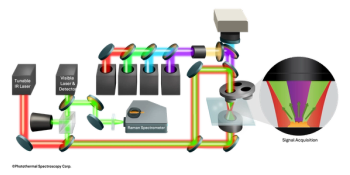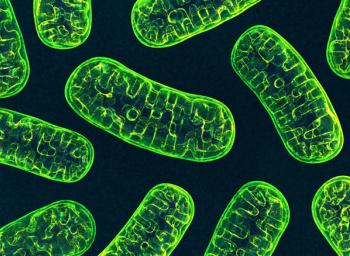
- Advances in Fluorescence Spectroscopy
- Volume 35
- Issue S5
An Ultrasensitive Fluorescence Method for Mercury Ion Detection Based on Mercury Nanoladder Signal Amplification and Thiazole Orange
Of all the heavy metals that contaminate tobacco, divalent mercuric ion is one of the most dangerous. Thus, a novel label-free and enzyme-free fluorescent method, based on mercury nanoladders integrated with thiazole orange (TO), was developed for rapid, sensitive, and selective detection of Hg2+ in aqueous solutions. In this study, we have determined that, in the presence of mercury ions, the thymine bases in probe 1 (P1) and probe 2 (P2) interact with Hg2+ to form a stable T-Hg2+-T structure, then long double helices of Hg2+ nanoladders will eventually result. Subsequently, the fluorescence of the TO dye was strongly enhanced, due to the binding of TO dye to long dsDNA. The increase in fluorescence intensity was linear with Hg2+ concentration in the range of 0.02–5 nM, and the limit of detection for this method was 20 pM. In addition, this method exhibits high selectivity, and experiments with tobacco samples also showed good results. We believe that the proposed system accurately and efficiently detects mercury ions within different substrates.
In recent years, because of the use of non-ferrous metal minerals, coal-fired flue gas, and solid waste incineration, a large quantity of heavy metals and toxic substances has been produced, resulting in an increased risk of excessive mercury in tobacco (1–4). Heavy metal ions in tobacco, especially mercury ions, can pose a serious health threat to smokers (5–7). Thus, it is urgent to develop accurate, sensitive, and very specific analytical methods for the determination of trace mercury ions in tobacco.
Various detection methods have been proposed to monitor trace amounts of mercury ions, including atomic absorption spectroscopy (AAS) (8,9), inductively coupled plasma–optical emission spectroscopy (ICP-OES) (10), and gas chromatography (GC) (11). Although these methods are very sensitive and accurate, they tend to be tedious and time-consuming, and depend on expensive instrumentation and professionally trained operators, thus limiting their application. At the same time, colorimetric sensors (12,13), electrochemical sensors (14,15), and fluorescence sensors (16–18) have also been developed to detect mercury ions. However, the colorimetric methodologies require modifications or additional materials to generate a signal response, and electrochemical methods have inherent disadvantages associated with modification requirements and instability of the electrodes. Therefore, fluorescence methods have been developed for mercury ion detection because of their advantages of stability, simplicity, and speed. For example, Wang and associates (16) reported a fluorescent probe based on branch migration for highly sensitive detection of mercury. Hu and associates (17) developed a DNA@MOF biosensor for successive and specific detection of Hg2+. In addition, Huang and colleagues (18) developed a sensitive detection method for mercury ions by exonuclease signal amplification. However, cumbersome fluorophore labeling and enzyme-assisted signal amplification makes the above methods complicated and expensive. Thus, to solve the above problems, we have developed an enzyme-free and label-free fluorescence method, based on mercury nanoladder signal amplification and thiazole orange (TO), to detect Hg2+.
This paper explains a simple and enzyme-free assay we have constructed for mercury ion detection based on mercury nanoladder signal amplification integrated with TO. A mercury nanoladder consists of a long double-stranded structure and relatively short sticky ends that are essentially nicked double helices of alternating copolymers (19). TO is a special asymmetric cyanine dye that has a weak fluorescence signal in aqueous solutions, but that exhibits a considerably increased fluorescence intensity when it interacts with double-stranded DNA (20,21). This occurs because when the dye binds to the nucleic acid through the positive and negative charge electrostatic attraction, the quinoline ring becomes embedded in the small groove of the double-stranded DNA molecule. Dye molecules are more planar, due to their steric hindrance, and thus exhibit increased fluorescence enhancement (22). The system discussed in the present study contains two specially designed oligonucleotide probes, probe 1 (P1) and probe 2 (P2). The interaction between thymine and Hg2+ forms T-Hg2+-T structures, resulting in the formation of nanoladders in the presence of Hg2+. In this state, TO can embed in the mercury nanoladders, producing a strong fluorescence emission. Compared with previous methods, this method has the advantages of a simple design, high sensitivity, and reduced cost, and may contribute to increased application prospects for heavy metal detection.
Materials and Methods
Materials and Reagents
The thymine-rich probe DNA sequences ([P1:5′-ATGCTTCGTTGTCTGTGCCT TCGTGTTGCA-3′] and [P2:5′-ACGGTT GCTCTTCGTTACGTTGCTTCTGAC-3′]) were obtained from Sangon Biotechnology Co., Ltd., and were dissolved in a Tris-HCl buffer (pH 7.4, 20 mM). All the synthetic DNA sequences are listed in Table I. These samples were stored at 4 oC for immediate use and long-term preservation. All other chemicals were obtained directly from commercial sources and used as received. Hg(NO3)2 was purchased from Sigma Aldrich, and dissolved in 0.5% HNO3. The thiazole orange (TO) was obtained from Tianjin Seans Biochemical Technology Co., Ltd. All other reagents were analytical grade and used without further purification or modification. Ultrapure water used throughout was produced from a Milli-Q water purifying system.
Apparatus
DNA fluorescence intensity was measured at the excitation spectra of 501 nm, using a spectrofluorophotometer (RF-5301PC, Shimadzu) where the slits were set to 5.0 and 5.0 nm for excitation and emission, respectively. The method was evaluated at a fluorescence intensity of 538 nm, which has been demonstrated to be the maximum emission intensity wavelength. Absorbance spectral measurements were carried out on a UV-2450 spectrophotometer (Shimadzu Co.). Native polyacrylamide gel electrophoresis was performed on a DYY-6C electrophoresis (Liuyi Biological Technology Co.).
Active Polyacrylamide Gel Electrophoresis
In a typical experiment, samples 1,2, and 3 included P1, P2, and P1+P2, respectively. Sample 4 was the mixture of P1, P2, and Hg2+. All of the samples were incubated at 37 oC for 30 min. We used 12% PAGE gel in a 1xTBE buffer for analysis of the product, and then gel electrophoresis was run for 70 min at a stable voltage of 100 V. Finally, the gel was stained with Stain-All, and then photographed after decolorization.
Fluorescence Measurement
The DNA probes (P1 and P2) were diluted with Tris-HCL buffer, to give the stock solutions. Then, a 250 μL reaction sample, containing 50 nM P1, 100 nM P2, 1 μM thiazole orange (TO), and different concentrations of Hg2+, was prepared in a Tris-HCl buffer, followed by incubation for 30 min. The fluorescence intensity of TO was measured at 520–600 nm, where the maximum emission peak was 538 nm.
Real Sample Analysis
We weighed 0.5 g of a tobacco sample into a PTFE digested flask, and then 3.0 mL of concentrated nitric acid and 5.0 mL of 30% hydrogen peroxide were added. The digestate evaporated to near dryness. The residue was dissolved in 5 mL of 5% nitric acid, then the pH was adjusted to near neutral with NaOH and transferred to a 50 mL volumetric flask.
Results and Discussion
Principle of Hg2+
Fluorescence Detection
The principle of the proposed method for rapid, label-free, and enzyme-free Hg2+ detection is demonstrated in Figure 1. In this study, the system contains two specially designed oligonucleotide probes: the thymine-rich probe 1 (P1), and the thymine-rich probe 2 (P2), with both including two T-rich domains. The background signal of this system is low in the absence of Hg2+, owing to P1 and P2 coexisting stably and remaining single-stranded. When Hg2+ was introduced into the system, the interaction between thymine and Hg2+ forms T-Hg2+-T structures, resulting in mercury nanoladders. This cascade reaction will continue until the supply of the Hg2+ ions is exhausted. In this state, TO could be embedded in the mercury nanoladders, producing a very strong fluorescent signal. The UV spectra of TO is shown in Figure 2a, and the excitation and emission spectra of TO are shown in Figure 2b, which are 501 nm and 538 nm, respectively.
Feasibility of the Design
To validate the feasibility of the proposed method for detecting Hg2+, the emission spectra obtained by fluorescence detection of samples containing different components were analyzed, as shown in Figure 3. From Figure 3, it was observed that, in the absence of Hg2+, the mixture composed of P1 and P2 produced relatively weak fluorescence emission. In the mixed solution of P1, P2, and Hg2+, the fluorescence intensity of TO increased significantly; this may be due to an increase of the double-chain structure in the solution.
Gel electrophoresis experiments were used to further verify the feasibility of the method and the formation of the mercury nanoladder produced by the addition of the target. As shown in Figure 4, the mercury nanoladders product was obvious in Lane 4, proving the feasibility of the amplification system.
Optimized Experimental Conditions
The ratio of probes P1 to P2 that affects the fluorescence intensity of the product was optimized. The concentration ratio of probes P1 and P2 was experimentally measured from 1:1 to 1:3, as shown in Figure 6. It can be seen that a ratio of P1:P2 = 1:2 affords the best signal-to-background difference (F/F0-1= [F-F0]/F0, where F and F0 represent the fluorescence intensity of the solution in the presence and absence of Hg2+, respectively, and the fluorescence was strongest at 1:2. Therefore, it was determined that at a 1:2 concentration ratio of the probes P1 and P2, the optimum concentration ratio is obtained.
It is worth noting that using TO as the dye agent plays a very important role in the detection of fluorescent signals, and, therefore, it is necessary to optimize the concentration of TO. As shown in Figure 5b, when the concentration of TO is increased from 0.25 μM to 2 μM, a fluorescence emission was observed for detection at a maximum of 1 μM. Therefore, 1 μM is taken as the optimum concentration of TO.
In addition, Mg2+ can promote DNA hybridization and requires optimization of the Mg2+ concentration. When the Mg2+ concentration increases, it is observed that the binding efficiency of P1 and P2 is higher, and F/F0-1 is gradually increased. However, at higher concentrations, the background signal is high and F/F0-1 gradually decreases. Figure 5c shows that the fluorescence intensity ratio F/F0-1 reaches a maximum at 1 mM. Therefore, 1 mM of Mg2+ was used as the optimum concentration in the assay.
Temperature is an important factor in the reaction, and the intensity of the fluorescence signal is different at different temperatures. As shown in Figure 6a, the fluorescence signal is highest at 37 oC so the overall system reaction is optimized at this temperature.
Incubation time is another important factor affecting the strength of the fluorescence signal. It can be concluded from Figure 6b that a platform is reached by the intensity of the fluorescence signal after more than 30 min of incubation time. Therefore, 30 min pours can be used as the best time for reaction.
Assay Performance of the Method
In order to understand the sensitivity of this method, the change in fluorescence intensity of Hg2+ was used to quantitatively detect Hg2+ concentration. From the Figure 7a, the fluorescence signal can be enhanced with the increase of Hg2+ concentration under optimal conditions. As shown in Figure 7b, when the Hg2+ concentration was from 0.02 nM to 5 nM, the linear regression equation was ∆F = 12.23C + 4.998, and the correlation coefficient is R2 = 0.9900. ∆F and C represent the fluorescence intensity difference and the Hg2+ concentration, respectively. The detection limit of Hg2+ was calculated to be 20 pM. The Hg2+ detection limits previously reported for various methods are listed in Table II.
Selectivity of Hg2+ Detection
To overcome the interference of other ions with Hg2+, it is valuable to measure the selectivity of Hg2+ by changing different metal ion targets under the same conditions, such as Ni2+, Zn2+, Cu2+, Cd2+, Pb2+, Mn2+, and Ca2+, respectively. As shown in Figure 8, 1 μM Hg2+ significantly altered the intensity of the fluorescent signal in the selective experiment. By comparison, it is found that the interfering metal ions (including Ni2+, Zn2+, Cu2+, Cd2+, Pb2+, Mn2+, and Ca2+) had no positive effect on the fluorescent signal. At the same time, when other interfering ions and mercury ions are mixed, the change in fluorescence intensity is not much different from that in the presence of mercury ions alone. This result indicates that the present strategy exhibits excellent selectivity for the detection of Hg2+, and is not easily interfered by competing ions, resulting in more accurate results.
Analysis of Real Samples
The proposed method has been successfully applied to the determination of mercury in tap water and tobacco. The recovery of mercury ion by adding different concentrations of mercury ion in a sample was carried out, and the results are shown in Table III. The data in the Table III reveals that the proposed methodology offers great potential for the specific detection of Hg2+ in tobacco samples.
Conclusion
We have successfully described a sensitive and selective detection method for mercury ions by using mercury nano-ladder signal amplification. P1 and P2 formed a long double-stranded complex after adding mercury ions, also named mercury nanoladders, that had the ability to combine with TO to produce a strong fluorescence emission. Consequently, this approach possesses a significant advantage of avoiding cumbersome labeling procedures and enzymes. At the same time, the method also exhibits excellent sensitivity and selectivity with a limit of detection of 20 pM. Moreover, the system can be practically applied for the detection of Hg2+ in tobacco samples, showing an extensive application prospect. The success of the system suggests that it can be employed as a universal sensor for more substrates.
Acknowledgment
This work was supported by the Basic Research Foundation of Yunnan Province (Nos. 2016CP021, 2017FD236), the Basic Research Foundation of China Tobacco Yunnan Industrial Co., Ltd. (No. 2019XY01, 2018JC04), the Project Foundation of Yunnan Key Laboratory of Tobacco Chemistry (KCFZ-2017-1096) and the Technology talent and platform program of Yunnan province (No. 2019HB079).
References
(1) S. Haque, M. Zeyaullah, G. Nabi, and P.S. Srivastava, J. Microbiol. Biotech. 20, 917–924 (2010).
(2) E.M. Suszcynsky and J.R. Shann, Environ. Toxicol. Chem. 14, 61–67 (1995).
(3) J.Z. Wang, S.Y. Ren, G.F. Zhu, L. Xi, Y.G. Han, Y. Luo, and L.F. Du, J. Mol. Struct. 1052, 85–92 (2013).
(4) J.J. Deng, Y. Zhang, J.W. Hu, Y. Yi, X.K. Su, X.F. Huang, and F.X. Qin, Hubei Agr. Sci. 5 (2009).
(5) Y. Xu, X. Niu, H. Zhang, L. Xu, S. Zhao, H. Chen, and X. Chen, J. Agr. Food Chem. 63, 1747–1755 (2015).
(6) X. Hu, W. Wang, and Y. Huang, Talanta 154, 409–415 (2016).
(7) Y. Liu, O.Q, H. Li, M. Chen. Z. Zhang, and Q. Chen, J. Agr. Food Chem. 66, 6188– 6195 (2018).
(8) Y. Gao, Z. Shi, Z. Long, P. Wu, C. Zheng and X. Hou, Microchem. J. 103, 1–14 (2012).
(9) M. Ghaedi, M. Reza Fathi, A. Shokrollahi and F. Shajarat, Anal. Lett. 39, 1171–1185 (2006).
(10) N.H. Bings, A. Bogaerts, and J.A.C. Broekaert, Anal. Chem. 78, 3917–3946 (2006).
(11) W.F. Fitzgerald and G.A. Gill, Anal. Chem. 51, 1714–1720 (1979).
(12) W. Feng, X. Xue, and X. Liu. J. Am. Chem. Soc. 130, 3244–3245 (2008).
(13) W. Ren, Y. Zhang, W.T. Huang, N.B. Li, and H.Q. Luo, Biosens. Bioelectron. 68, 266–271 (2015).
(14) F. Tan, L. Cong, N.M. Saucedo, J. Gao, X. Li, and A. Mulchandanib, J. Hazard. Mater. 320, 226–233 (2016).
(15) A. Shirzadmehr, A. Afkhami, and T. Madrakian. J. Mol. Liq. 204, 227–235 (2015).
(16) S. Wang, B. Lin, L. Chen, N. Li, J. Xu, J. Wang, Y. Yang, Y. Qi, Y. She, X. Shen, and X. Xiao. Anal. Chem. 90, 11764–11769 (2018).
(17) P.P. Hu, N. Liu, K.Y. Wu, L.Y. Zhai, B.P. Xie, B. Sun, W.J. Duan, W.H. Zhang, and J.X. Chen, Inorg. Chem. 57, 8382–8389 (2018).
(18) H. Huang, S. Shi, X. Zheng, and T. Yao, Biosens. Bioelectron. 71, 439–444 (2015).
(19) Y. Feng, X. Shao, K. Huang, J. Tian, X. Mei, Y. Luo, and W. Xu, Chem. Commun. 54, 8036–8039 (2018).
(20) I. Timtcheva, V. Maximova, T. Deligeorgiev, D. Zaneva, and I. Ivanov, J. Photochem. Photobiol. A 130, 7–11 (2000).
(21) M. Jin, X. Liu, X. Zhang, L. Wang, T. Bing, N. Zhang, Y. Zhang, and D. Shangguan, ACS Appl. Mater. Interfaces 10, 25166–25173 (2018).
(22) I. Timtcheva, V. Maximova, T. Deligeorgiev, N. Gadjev, R. Sabnis, and I. Ivanov, FEBS Letters 405, 141–144 (1997).
(23) Y. Zhu, Y. Cai, Y. Zhu, L. Zheng, J. Ding, Y. Quan, L. Wang, and B. Qi, Biosens. Bioelectron. 69, 174–178 (2015).
(24) Y. Lv, L. Yang, X. Mao, M. Lu, J. Zhao, and Y. Yin, Biosens. Bioelectron. 85, 664–668 (2016).
(25) T. Bao, W. Wen, X. Zhang, Q. Xia, and S. Wang, Biosens. Bioelectron. 70, 318–323 (2015).
(26) Q. Fang, Q. Liu, X. Song, and J. Kang, Luminescence 30, 1280–1284 (2015).
(27) W. Yun, W. Xiong, H. Wu, M. Fu, Y. Huang, X. Liu, and L. Yang, Sensor. Actuat. B: Chem. 249, 493–498 (2017).
(28) S. Wang, X. Li, J. Xie, B. Jiang, R. Yuan, and Y. Xiang, Sensor. Actuat. B: Chem. 259, 730–735 (2018).
Xiaoxi Si, Juan Li, Yuanxing Duan, Yuting Yang, Yuandong Li, Chunbo Liu, Yang Zhao, Fengmei Zhang, Jianjun Xi, Qinpeng Shen, and Zhihua Liua are with the Yunnan Key Laboratory of Tobacco Chemistry, at China Tobacco Yunnan Industrial Co., Ltd., in Kunming, in the People's Republic of China. Chngqun Cai is with the Key Laboratory for Green Organic Synthesis and Application of Hunan Province, at the Key Laboratory of Environmentally Friendly Chemistry and Application of Ministry of Education, at the College of Chemistry of Xiangtan University, in Xiangtan in the People's Republic of China. Direct correspondence to: ashb345@126.com
Articles in this issue
about 5 years ago
A Full Spectroscopic Study of Pr:YLF Crystals Used in Lasersabout 5 years ago
Catalytic Kinetic Fluorimetric Detection of Trace Amounts of Bismuthabout 5 years ago
Advances in Fluorescence Spectroscopy: A Peer-Reviewed Special IssueNewsletter
Get essential updates on the latest spectroscopy technologies, regulatory standards, and best practices—subscribe today to Spectroscopy.


![Figure 3: Plots of lg[(F0-F)/F] vs. lg[Q] of ZNF191(243-368) by DNA.](https://cdn.sanity.io/images/0vv8moc6/spectroscopy/a1aa032a5c8b165ac1a84e997ece7c4311d5322d-620x432.png?w=350&fit=crop&auto=format)

